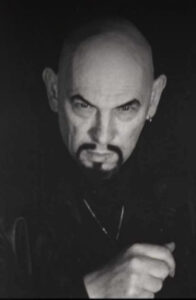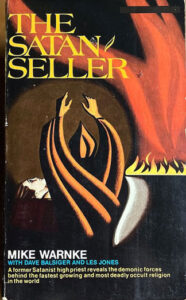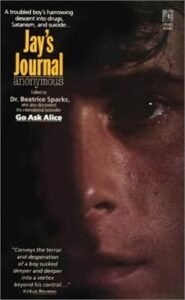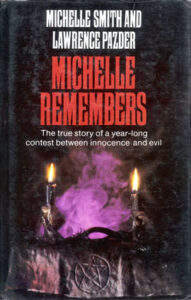The Satanic Panic: an analysis – I
A major theme in Delinquent Elementals, edited by me and Rodney Orpheus, is the British Satanic Panic of 1988-1992. For this series of posts, I’m going to examine the background to the “Panic” and various contributing factors. For the first few posts, I’ll concentrate on the North American Satanic Panic that preceded and influenced the British phenomena.
Part 1: The Background to the North American Satanic Panic
The various “Panics” that swept North America during the late 1970s and into the 1980s were symptoms of sweeping cultural changes that produced anxieties in segments of American society – particularly amongst conservatives, libertarians, and Evangelical Christians. Despite their differences, these seemingly disparate groups shared an antagonism towards the liberal progressive movements of the 1960s such as feminism, black rights activists, and LGBT liberation. By the mid-70s, many evangelicals and conservatives were increasingly of the opinion that traditional values, and in particular, the sanctity of the family was under threat from a variety of cultural trends, ranging from sexual permissiveness, women’s equality, to government-supported childcare and abortion. There were also concerns about foreign religious influences, cults, and heavy metal music. As Robert Self puts it, “Family had quite suddenly and powerfully joined communism and civil rights as the battlegrounds on which conservatives would wage war against liberalism”.1 The family, in their view, stood for the nation itself, and in the face of an increasing threat to the sanctity of the family, politicized Christians began to agitate for a return to religious values and argued that those values must shape national life and public policy.
A turning point was the election of Ronald Reagan in 1980, supported by 67 percent of white evangelical voters.2 Reagan, during his election campaign, made it clear that he supported so-called “pro-life” values, and spoke out against “a wave of humanism and hedonism” that had afflicted America. Reagan was the first to popularise the phrase “Let’s make America Great Again.” He also reframed the Cold War in religious terms, speaking of “godless communism,” and supported limiting federal power, promising to keep the government out of schools and the home. Empowered by a supportive president in the White House, Christian and conservative activists began to flex their political muscles.
The ascendancy of evangelical Christianity was also spurred on by changes in the media landscape. Sarah Hughes, in her paper, American Monsters, points to the growth of domestic television ownership and sensational television reporting, or “infotainment”3 as significant to America’s moral panics. The rise of tabloid-style television promoted and reinforced conservative anxieties as news, feeding the perception of traditional family life as being under threat from a wide variety of sources – ranging from criminal gangs to sixties liberals. Beliefs and anxieties were both reflected and reified by television.
This period also saw a dramatic rise in Christian use of the media. By the early 1980s, there were over a dozen evangelical US-based Christian ministries broadcasting television shows nationwide and globally. It has been estimated that by the early 1980s, of the 400,000 churches in the United States, over a quarter were evangelical or fundamentalist, attended by between twenty to thirty million Americans.
This period was one of numerous campaigns against a variety of social evils that conservatives saw as indicative of the country’s declining morality, and these were often couched as threats to children. They included The Partnership for a Drug-Free America (PDFA), and the Parents Resource Music Centre (PRMC), both of which focused their attention on reaching out to concerned parents (and Congress) through the media. A public opinion poll undertaken in 1980 showed that 60% percent of respondents believed that pornography was linked to national moral decline; 73% agreed that homosexuality was morally wrong; and 66% had more confidence in their religious leaders than they did in Congress, the Supreme Court, or the military.4
Both the campaign against Fantasy Role-Playing Games, and the Satanic Panic of the eighties can be understood as symptomatic of the concern for the family and children. These panics were also fuelled by key developments.
1 Rediscovering child abuse
In 1962, a Denver paediatrician Dr. C. Henry Kempe published a ground-breaking national study in the Journal of the American Medical Association (JAMA) dealing with “non-accidental injuries of children” – the Battered Children Syndrome. This survey brought to public attention the shocking realization that child abuse was widespread in America and that it was carried out by children’s parents. More surveys were carried out, and during the 1960s, states began to pass laws requiring that suspected cases of child abuse were to be reported. Judith Sealander, in her book The Failed Century of the Child, gives an example of Florida. In 1965, child protection services reported 16 cases of child abuse across the entire state. By 1971, that number had risen to 250, and in 1972, following a television and radio campaign, it leapt to 14,000.5
The first attempts to theorize the causes and consequences of child abuse were made by feminist scholars. On April 17, 1971, a psychiatric social worker, Florence Rush for the New York Society for the Prevention of Cruelty to Children gave a conference presentation entitled The Sexual Abuse of Children: A Feminist Point of View. Rush explained how the nineteenth century had created the image of the “innocent child”. She criticized explanations of child abuse derived from Freudian thinking and instead focused on power structures – “a social milieu where male sexual power over women and children is institutionally integrated.” She was equally critical of conservatives who believed that the family was a benign institution, and those progressives who thought that the sexual revolution would cause all sexual problems to disappear. Yet the perspective that examined structural causes of child abuse – poverty and inequality for example – was not popular. The dominant narratives about child abuse were the ideas that the perpetrators were strangers or were suffering from mental illness. In other words, such people were aberrations from the norm. Whilst it was accepted that child abuse was a growing problem, the focus was on the psychological treatment of perpetrators and psychological support for victims. This emphasis on psychology helped spawn a wave of popular self-help books for adult survivors of sexual abuse, which by the 1980s, were best-sellers.
2 Satan Rising?
On Walpurgis Night 1966, one Anton LaVey stepped into the limelight by founding a new religious sect – The Church of Satan. LaVey’s combination of showmanship and anti-Christian provocation ensured that The Church of Satan – and LaVey himself, would become a media sensation. Satanism became a popular subject for Hollywood – beginning with Roman Polanski’s Rosemary’s Baby in 1968, there was a spate of films that featured the theme of Satan and cults such as I Drink Your Blood (1970), The Brotherhood of Satan (1971), The Devil’s Rain (1975) and of course The Exorcist (1973). During a period when the American public was reeling from Vietnam, mass anti-war demonstrations, the rise of civil rights movements, and the Kennedy and King assassinations, these films showed traditional values threatened and families in disintegration, but the root cause was supernatural evil, not social problems.
The 1970s also saw the appearance of several popular satanic “survivor” narratives. In 1972, Mike Warnke’s book The Satan Seller was released. The Satan Seller is Warnke’s supposedly autobiographical account of how he became involved in Satanism and participated in the usual satanic hi-jinks – orgies, selling drugs, summoning demons and ritual sex – and rising through the ranks of the satanic hierarchy to become a “High Priest”. The Satan Seller made Warnke a popular figure in evangelical circles, and he quickly gained a reputation as a Christian comedian, as well as lecturing and practising his own ministry. In 1985 he appeared on ABC’s 20/20 report The Devil Worshippers as an expert on Satanism.
In 1992 the Christian magazine Cornerstone published an expose of Warnke’s claims, showing that, for example, when he claimed to have met Charles Manson in January 1966, Manson was in jail at the time.6 Their findings were later published as Selling Satan: The Evangelical Media and the Mike Warnke Scandal.
Another influential book was Jay’s Journal, published in 1978. Jay’s Journal: The shocking diary of a 16-year-old helplessly drawn into a world of witchcraft and evil was presented by its author, Beatrice Sparks, as the edited diary of a Mormon teenager – Alden Barrett of Utah – who had taken his own life in 1971. Barrett’s family had given the diary to Sparks, whose previous novel Go Ask Alice had been a best-seller. In Sparks’ hands, the diary became a salutary warning about the dangers for teenagers presented by the occult and drug-taking. “Jay” is presented as a gifted youth, something that makes him all the more vulnerable to the temptations of the occult. After an arrest for selling drugs, Jay meets an occult practitioner. Later, Jay, together with two friends and his “bewitched” girlfriend, dabbled with the occult, experimented with Ouija boards and chants, performed animal sacrifice, and drank blood. They became involved with a cult, participated in sadistic orgies, and Jay learned the occult arts of levitation. His girlfriend Tina influenced the outcome of a high-school election using a voodoo doll. Finally, Jay and his friends make a pact with the Devil, with death as the forfeit should they dare to break it. Jay’s friends both die in car-related accidents when they resolve to confess what they have been up to their bishop. Jay, whilst in a state of possession by a demon named Raul, shoots himself in the head.
Alden Barrett’s brother, Scott, later published a book, A Place in the Sun: The Truth Behind Jay’s Journal, claiming that very few of the diary entries (21 out of a total of 212) in Jay’s Journal were based on Alden Barrett’s actual diary.
3 Multiple personalities and Recovered memory
The idea of multiple personalities first came to public attention in 1954 when two hypnotherapists – Corbett H. Thigpen and Hervey M. Cleckley – published “A Case of Multiple Personality” in The Journal of Abnormal and Social Psychology. There was so much interest in the case that an Academy Award-winning film The Three Faces of Eve was released in 1957 (the two therapists helped write the screenplay). Shortly after the film’s release, Thigpen and Cleckley reported that they’d had dozens of calls from female patients saying they too were suffering from the same condition.
In 1973, Flora R. Schreiber’s novel Sybil: The True Story of a Woman Possessed by 16 Separate Personalities was published. The novel was based on the life of Shirley Mason, who had been diagnosed as suffering from what was then termed “Multiple Personality Disorder” (now “Dissociative Identity Disorder”). She allegedly had 16 multiple personalities – each with their seperate memories and would frequently find herself in strange places with no memory of how she arrived there. Schreiber, in her retelling, suggested that Mason had generated these personalities to cope with the stress of childhood sexual abuse by her mother. Sybil was a hit, selling over 6 million copies, and did much to popularise the idea of multiple personalities and their relationship to child sexual abuse.
Sybil was made into a television movie in 1976. A recent book by Debbie Nathan, Sybil Exposed challenges the idea that Sybil was an accurate description of Shirley Mason’s life and is highly critical of the diagnostic category of Dissociative Identity Disorder.
In 1980, a book was published that did much to lay the groundwork for the escalation of claims of Satanic Ritual Abuse throughout the next two decades: Michelle Remembers – an account by a claimed survivor of Satanic Ritual Abuse Michelle Smith and her therapist Lawrence Padzer. The book details the memories of Michelle concerning her childhood experiences of ritual abuse by a satanic group that her mother belonged to. The account details bizarre satanic rituals taking place in cemeteries, mausoleums, offices, and homes across British Columbia between 1954-55. This abuse ceased, according to the account, when Jesus Christ and the Virgin Mary personally interceded on behalf of Michelle. These memories were brought to the surface with the aid of Padzer, in sessions that lasted as long as six hours. The book was a best-seller, and both Padzer and Smith became the focus of intense media interest, appearing on television and radio shows and embarking on a lecture tour. Padzer later coined the term “ritual abuse”, defining it as “repeated physical, emotional, mental and spiritual assaults” which are enacted through a “systematic use of symbols, ceremonies, and machinations designed and orchestrated to attain malevolent effects”. Soon after the publication of the book, Padzer was successfully sued for libel by the Church of Satan and forced to withdraw his allegation that the Church had been responsible for Michelle’s abuse.
That same year also saw the third edition of the Diagnostic and Statistical Manual of the American Psychiatric Association (DSM-III) which for the first time included the diagnostic category “Multiple Personality Disorder” (later “Dissociative Identity Disorder”). Although the diagnostic category was thought to be very rare, its inclusion in DSM-III made it “real”. One result was that patients who received this diagnosis could apply to their insurance companies to afford the prolonged and intensive therapy that therapists who specialized in MPD insisted was required. Over the next ten years, cases of MPD leapt from a handful to thousands, and it became a common diagnosis applied to those thought to have been victims of Satanic Abuse.
In the next post, I’ll examine the so-called “Dungeons & Dragons” panic.
- Robert Self, All in the Family: The Realignment of American Democracy Since the 1960s. New York. Hill and Wang. 2012. ↩︎
- Daniel K. Williams, Reagan’s Religious Right: the Unlikely Alliance between Southern Evangelicals and a California Conservative. in Hudson, Cheryl and Davies, Gareth (eds) “Ronald Reagan and the 1980s: Perceptions, Policies, Legacies. New York. Palgrave MacMillan. 2008. ↩︎
- Sarah Hughes, “American Monsters: Tabloid Media and the Satanic Panic, 1970-200”, in Journal of American Studies 51 (2017), 3, pp691-719. ↩︎
- Mary de Young, The Day Care Ritual Abuse Moral Panic. Jefferson, North Carolina. McFarland & Company, Inc. 2004. ↩︎
- Judith Sealander. The Failed Century of the Child: Governing America’s Young in the Twentieth Century. Cambridge University Press, 2009. p66. ↩︎
- Archived here ↩︎




